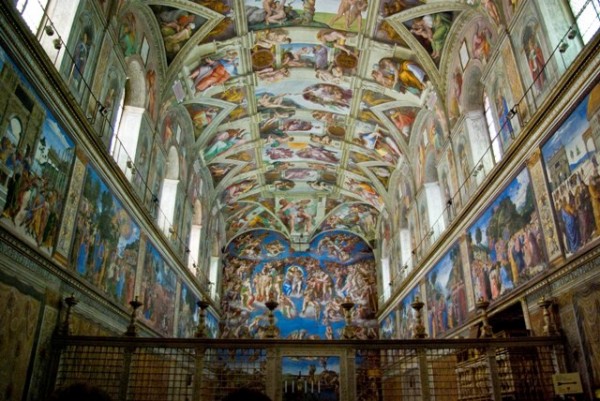Sistine Chapel Gets A Cooler Makeover
| Marco Foronda | | Nov 02, 2014 03:51 AM EST |
(Photo : wikipedia.org) The Sistine Chapel
The Sistine Chapel gets a high-tech makeover for a brighter and more sophisticated new look.
On Thursday, the Vatican revealed the state-of-the art illumination and air conditioning system for the chapel. The new design aims to better show off the chapel's sophisticated frescoes, and at the same time, protect them from the unavoidable dirt, breath and heat from the so many visitors passing through each day just to stare at the Michelangelo’s masterpiece.
Like Us on Facebook
The Vatican officials said that the existing 20 year-old air conditioning system was not able to maintain the humidity and temperature levels required to protect the frescoes.
The new air conditioning and air filtration system will adjust the air flow, humidity and temperature levels with the help of the 70 sensors mounted in the chapel walls.
It has two closed-circuit TV cameras that will count the number of people inside the chapel at any given time. The AC system maintains 68 to 77 degrees Fahrenheit and keeps dust particles and air flow within parameters set by the Vatican’s art experts.
Meanwhile, the illumination system has 7,000 LED lights that will bring out the deep blue background of Michelangelo’s “Last Judgment” and showcases the lives of Moses and Christ along the chapel walls.
The Vatican officials noticed the patina in 2010 and conducted an immediate investigation. The damage was only visible with close inspection and it revealed that there have been pockets of the frescoes covered with a powdery patina that resulted into cracked sugar icing-like.
“The concern was not just aesthetic but also the danger for the integrity of the paintings,” said Vittoria Ciminio, head of the Vatican Museums’ conservation department, in a conference on Thursday.
Officials have no idea where the damage originated, but they stated that the powder composed of calcium carbonate and calcium bicarbonate deposits were formed from the increasing levels of carbon dioxide and humidity passing via the chapel's porous plaster walls.
Ulderico Santamaria, head of the museums’ restoration laboratory, said that the project aims to prevent potential damage from the air pollution caused by nearly six million visitors.
TagsSistine Chapel, Vatican, Sistine Chapel makeover, Michelangelo, Michelangelo’s “Last Judgment”, Last Judgment
©2015 Chinatopix All rights reserved. Do not reproduce without permission
EDITOR'S PICKS
-

Did the Trump administration just announce plans for a trade war with ‘hostile’ China and Russia?
-

US Senate passes Taiwan travel bill slammed by China
-

As Yan Sihong’s family grieves, here are other Chinese students who went missing abroad. Some have never been found
-

Beijing blasts Western critics who ‘smear China’ with the term sharp power
-

China Envoy Seeks to Defuse Tensions With U.S. as a Trade War Brews
-

Singapore's Deputy PM Provides Bitcoin Vote of Confidence Amid China's Blanket Bans
-

China warns investors over risks in overseas virtual currency trading
-

Chinese government most trustworthy: survey
-

Kashima Antlers On Course For Back-To-Back Titles
MOST POPULAR
LATEST NEWS
Zhou Yongkang: China's Former Security Chief Sentenced to Life in Prison

China's former Chief of the Ministry of Public Security, Zhou Yongkang, has been given a life sentence after he was found guilty of abusing his office, bribery and deliberately ... Full Article
TRENDING STORY

China Pork Prices Expected to Stabilize As The Supplies Recover

Elephone P9000 Smartphone is now on Sale on Amazon India

There's a Big Chance Cliffhangers Won't Still Be Resolved When Grey's Anatomy Season 13 Returns

Supreme Court Ruled on Samsung vs Apple Dispute for Patent Infringement

Microsoft Surface Pro 5 Rumors and Release Date: What is the Latest?










